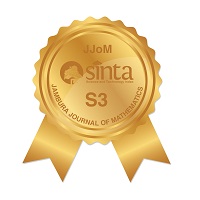Mathematical Analysis of Tuberculosis Transmission Model with Multidrug and Extensively Drug-resistant Incorporating Chemoprophylaxis Treatment
Abstract
Keywords
Full Text:
PDFReferences
D. Young, J. Stark, and D. Kirschner, "Systems biology of persistent infection: tuberculosis as a case study" Nature Reviews Microbiology, vol. 6, no. 7, pp. 520-528, 2008, doi: 10.1038/nrmicro1919.
V. K. Gupta, S. K. TIWAR Ë™ I, S. Sharma, and L. Nagar, "Mathematical model of tuberculosis with drug resistance to the first and second line of treatment" Journal of New Theory, no. 21, pp. 94-106, 2018.
D. Pal, D. Ghosh, P. Santra, and G. Mahapatra, "Mathematical analysis of a covid-19 epidemic model by using data driven epidemiological parameters of diseases spread in india" Biophysics, vol. 67, no. 2, pp. 231-244, 2022.
P. Santra, D. Ghosh, G. Mahapatra, E. Bonyah et al., "Mathematical analysis of two waves of covid-19 disease with impact of vaccination as optimal control" Computational and Mathematical Methods in Medicine, vol. 2022, 2022.
H. Waaler, A. Geser, and S. Andersen, "The use of mathematical models in the study of the epidemiology of tuberculosis" American Journal of Public Health and the Nations Health, vol. 52, no. 6, pp. 1002-1013, 1962.
A. Egonmwan and D. Okuonghae, "Analysis of a mathematical model for tuberculosis with diagnosis" Journal of applied mathematics and computing, vol. 59, pp. 129-162, 2019, doi: 10.1007/s12190-018-1172-1.
A. Kelemu Mengistu and P. J. Witbooi, "Modeling the effects of vaccination and treatment on tuberculosis transmission dynamics" Journal of Applied Mathematics, vol. 2019, pp. 1-9, 2019, doi: 10.1155/2019/7463167.
C. Bhunu, W. Garira, Z. Mukandavire, and M. Zimba, "Tuberculosis transmission model with chemoprophylaxis and treatment" Bulletin of Mathematical Biology, vol. 70, pp. 1163-1191, 2008, doi: 10.1007/s11538-008-9295-4.
S. Side, A. Utami, M. Pratama et al., "Numerical solution of sir model for transmission of tuberculosis by runge-kutta method" in Journal of Physics: Conference Series, vol. 1040, no. 1. IOP Publishing, 2018, p. 012021, doi: 10.1088/1742-6596/1040/1/012021.
S. Athithan and M. Ghosh, "Mathematical modelling of tb with the effects of case detection and treatment" International Journal of Dynamics and Control, vol. 1, pp. 223-230, 2013, doi: 10.1007/s40435-013-0020-2.
D. B. Kitaro, B. K. Bole, and K. P. Rao, "Modeling and bifurcation analysis of tuberculosis with multidrugresistant compartment incorporating chemoprophylaxis treatment" Frontiers in Applied Mathematics and Statistics, vol. 9, p. 1264201, doi: 10.3389/fams.2023.1264201.
W. S. T. Strategy, "Implementing the who stop tb strategy" URL: WHO/HTm/TB/2008.401.
F. A. Oguntolu, O. J. Peter, K. Oshinubi, T. A. Ayoola, A. O. Oladapo, and M. M. Ojo, "Analysis and dynamics of tuberculosis outbreak: A mathematical modelling approach" Advances in Systems Science and Applications, vol. 4, pp. 144-161, 2022.
K. Oshinubi, O. J. Peter, E. Addai, E. Mwizerwa, O. Babasola, I. V. Nwabufo, I. Sane, U. M. Adam, A. Adeniji, and J. O. Agbaje, "Mathematical modelling of tuberculosis outbreak in an east African country incorporating vaccination and treatment" Computation, vol. 11, no. 7, p. 143, 2023, doi: 10.3390/computation11070143.
I. Syahrini, Sriwahyuni, V. Halfiani, S. M. Yuni, T. Iskandar, Rasudin, and M. Ramli, "The epidemic of tuberculosis on vaccinated population" in Journal of Physics: Conference Series, vol. 890, no. 1. IOP Publishing, 2017, p. 012017, doi: 10.1088/1742-6596/890/1/012017.
S. Egbetade, M. Ibrahim, and C. Ejieji, "On existence of a vaccination model of tuberculosis disease pandemic" International Journal of Engineering and Science, vol. 2, no. 7, pp. 41-44, 2013.
K. Q. Fredlina, T. Oka, and I. Dwipayana, "Sir (susceptible, infectious, recovered) model for tuberculosis disease transmission, j" Matematika, vol. 1, no. 1, pp. 52-58, 2012.
N. H. Shah and J. Gupta, "Mathematical modelling of pulmonary and extra-pulmonary tuberculosis" Inter. J. Math. Trends Technol. 4 (9): 158, vol. 162, 2013.
B. K. Mishra and J. Srivastava, "Mathematical model on pulmonary and multidrug-resistant tuberculosis patients with vaccination" Journal of the Egyptian Mathematical Society, vol. 22, no. 2, pp. 311-316, 2014, doi: 10.1016/j.joems.2013.07.006.
U. T. Mustapha, B. Idris, S. S. Musa, and A. Yusuf, "Mathematical modeling and analysis of mycobacterium tuberculosis transmission in humans with hospitalization and reinfection" Office of Czestochowa University of Technology, vol. 21, no. 1, pp. 55-66, 2022.
S. Suddin, E. N. Bano, and M. H. Yanni, "Mathematical modelling of multidrug-resistant tuberculosis with vaccination" MATEMATIKA: Malaysian Journal of Industrial and Applied Mathematics, pp. 109-120, 2021.
Y. Yu, Y. Shi, and W. Yao, "Dynamic model of tuberculosis considering multi-drug resistance and their applications" Infectious disease modelling, vol. 3, pp. 362-372, 2018, doi: 10.1016/j.idm.2018.11.001.
O. Diekmann and J. A. P. Heesterbeek, Mathematical epidemiology of infectious diseases: model building, analysis and interpretation. John Wiley & Sons, 2000, vol. 5.
M. Ronoh, R. Jaroudi, P. Fotso, V. Kamdoum, N. Matendechere, J. Wairimu, R. Auma, and J. Lugoye, "A mathematical model of tuberculosis with drug resistance effects" Applied Mathematics, vol. 7, no. 12, pp. 1303-1316, 2016, doi: 10.4236/am.2016.712115.
DOI: https://doi.org/10.37905/jjom.v6i1.22127
Copyright (c) 2024 Damtew Bewket Kitaro, Boka Kumsa Bole, Koya Purnachandra Rao

This work is licensed under a Creative Commons Attribution-NonCommercial 4.0 International License.
Jambura Journal of Mathematics has been indexed by
Jambura Journal of Mathematics (e-ISSN: 2656-1344) by Department of Mathematics Universitas Negeri Gorontalo is licensed under a Creative Commons Attribution-NonCommercial 4.0 International License. Powered by Public Knowledge Project OJS.
Editorial Office
Department of Mathematics, Faculty of Mathematics and Natural Science, Universitas Negeri Gorontalo
Jl. Prof. Dr. Ing. B. J. Habibie, Moutong, Tilongkabila, Kabupaten Bone Bolango, Gorontalo, Indonesia
Email: [email protected].




















